Submitted:
13 September 2023
Posted:
14 September 2023
You are already at the latest version
Abstract
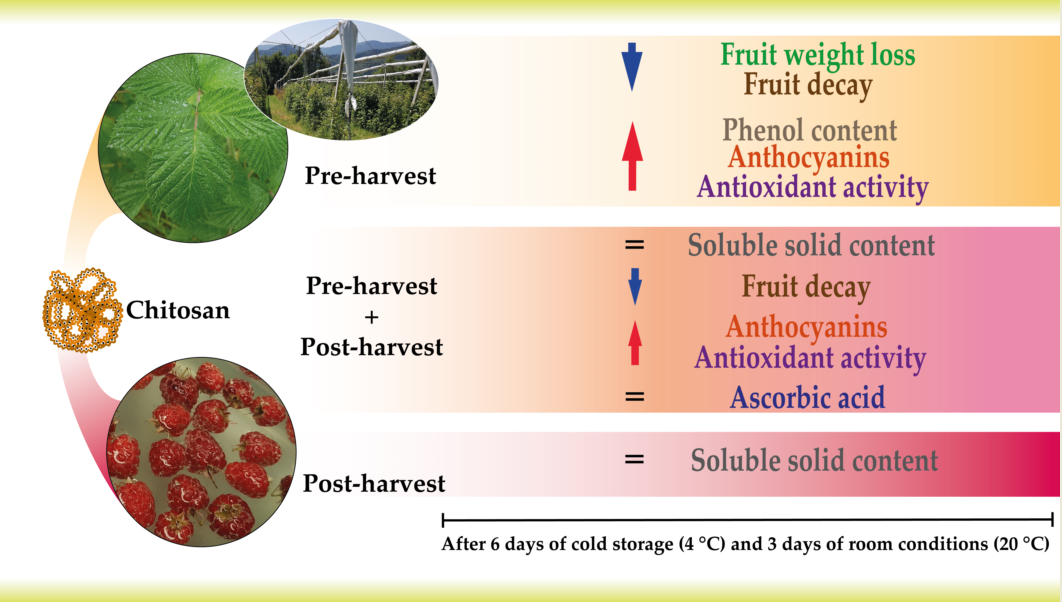
Keywords:
1. Introduction
2. Materials and Methods
2.1. Plant Material
2.2. Fruit Quality Parameters
2.3. Phenol Extraction and Analysis
2.4. Total antioxidant activity analysis
2.5. Total Anthocyanin Concentration
2.6. Ascorbic Acid Concentration
2.7. Fruit Decay Evaluation
2.8. Statistical Analysis
3. Results
3.1. Fruit Qualitative Parameters
3.2. Fungal Decay Evaluation
3.3. Fruit Antioxidant Analyses
4. Discussion
4.1. Fruit Qualitative Analyses
4.2. Fungal Decay on Treated and Untreated Raspberries
4.3. Fruit Antioxidant Properties
5. Conclusions
Author Contributions
Funding
Institutional Review Board Statement
Informed Consent Statement
Data Availability Statement
Acknowledgments
Conflicts of Interest
References
- IRO International Raspberry Organisation. (accessed on 8 April 2021).
- Statistics Division FAOSTAT- Food and Agriculture Organization of the United Nations Available online:. Available online: http://www.fao.org/faostat/en/#home (accessed on 1 July 2021).
- Rao, A.V.; Snyder, D.M. Raspberries and Human Health: A Review. J. Agric. Food Chem. 2010, 58, 3871–3883. [Google Scholar] [CrossRef] [PubMed]
- Raspberry: Breeding, Challenges and Advances; Graham, J. , Brennan, R., Eds.; Springer International Publishing: Cham, 2018; ISBN 978-3-319-99030-9. [Google Scholar]
- Vara, A.L.; Pinela, J.; Dias, M.I.; Petrović, J.; Nogueira, A.; Soković, M.; Ferreira, I.C.F.R.; Barros, L. Compositional Features of the “Kweli” Red Raspberry and Its Antioxidant and Antimicrobial Activities. Foods 2020, 9, 1522. [Google Scholar] [CrossRef] [PubMed]
- Beekwilder, J.; Jonker, H.; Meesters, P.; Hall, R.D.; van der Meer, I.M.; Ric de Vos, C.H. Antioxidants in Raspberry: On-Line Analysis Links Antioxidant Activity to a Diversity of Individual Metabolites. J. Agric. Food Chem. 2005, 53, 3313–3320. [Google Scholar] [CrossRef] [PubMed]
- Burton-Freeman, B.M.; Sandhu, A.K.; Edirisinghe, I. Red Raspberries and Their Bioactive Polyphenols: Cardiometabolic and Neuronal Health Links. Adv. Nutr. 2016, 7, 44–65. [Google Scholar] [CrossRef]
- Khanizadeh, S.; Rekika, D.; Ehsani-Moghaddam, B.; Tsao, R.; Yang, R.; Charles, M.T.; Sullivan, J.A.; Gauthier, L.; Gosselin, A.; Potel, A.-M.; et al. Horticultural Characteristics and Chemical Composition of Advanced Raspberry Lines from Quebec and Ontario. LWT - Food Sci. Technol. 2009, 42, 893–898. [Google Scholar] [CrossRef]
- Haffner, K.; Rosenfeld, H.J.; Skrede, G.; Wang, L. Quality of Red Raspberry Rubus Idaeus L. Cultivars after Storage in Controlled and Normal Atmospheres. Postharvest Biol. Technol. 2002, 24, 279–289. [Google Scholar] [CrossRef]
- Forney, C.F.; Jamieson, A.R.; Munro Pennell, K.D.; Jordan, M.A.; Fillmore, S.A.E. Relationships between Fruit Composition and Storage Life in Air or Controlled Atmosphere of Red Raspberry. Postharvest Biol. Technol. 2015, 110, 121–130. [Google Scholar] [CrossRef]
- Callesen, O.; Holm, B. Storage Results with Red Raspberry. Acta Hortic. 1989, 247–254. [Google Scholar] [CrossRef]
- Bermúdez-Soto, M.J.; A. Tomás-Barberán, F. Evaluation of Commercial Red Fruit Juice Concentrates as Ingredients for Antioxidant Functional Juices. Eur. Food Res. Technol. 2004, 219, 133–141. [Google Scholar] [CrossRef]
- Kempler, C.; Hall, H.; Finn, C.E. Raspberry. In Fruit Breeding; Badenes, M.L., Byrne, D.H., Eds.; Springer US: Boston, MA, 2012; pp. 263–304. ISBN 978-1-4419-0762-2. [Google Scholar]
- Lo Piccolo, E.; Martìnez Garcìa, L.; Landi, M.; Guidi, L.; Massai, R.; Remorini, D. Influences of Postharvest Storage and Processing Techniques on Antioxidant and Nutraceutical Properties of Rubus Idaeus L.: A Mini-Review. Horticulturae 2020, 6, 105. [Google Scholar] [CrossRef]
- Knight, V.H. Responses of Red Raspberry Cultivars and Selections to Botrytis Cinerea and Other Fruit-Rotting Fungi. J. Hortic. Sci. 1980, 55, 363–369. [Google Scholar] [CrossRef]
- Coates, L.; Johnson, G. Postharvest Diseases of Fruit and Vegetables. In Postharvest diseases of fruit and vegetables.; Rockvale Publications: Armidale, Australia, 1997; pp. 533–548. [Google Scholar]
- Zhang, D.; Quantick, P.C. Antifungal Effects of Chitosan Coating on Fresh Strawberries and Raspberries during Storage. J. Hortic. Sci. Biotechnol. 1998, 73, 763–767. [Google Scholar] [CrossRef]
- Alessandro Adobati; Eleonora Uboldi; Laura Franzetti; Sara Limbo Shelf Life Extension of Raspberry: Passive and Active Modified Atmosphere inside Master Bag Solutions. Chem. Eng. Trans. 2015, 44, 337–342. [CrossRef]
- Kozhar, O.; Peever, T.L. How Does Botrytis Cinerea Infect Red Raspberry? Phytopathology® 2018, 108, 1287–1298. [Google Scholar] [CrossRef] [PubMed]
- Swett, C.L.; Hamby, K.A.; Hellman, E.M.; Carignan, C.; Bourret, T.B.; Koivunen, E.E. Characterizing Members of the Cladosporium Cladosporioides Species Complex as Fruit Rot Pathogens of Red Raspberries in the Mid-Atlantic and Co-Occurrence with Drosophila Suzukii (Spotted Wing Drosophila). Phytoparasitica 2019, 47, 415–428. [Google Scholar] [CrossRef]
- Madrid, M.; Beaudry, R. Small Fruits: Raspberries, Blackberries, Blueberries. In Controlled and Modified Atmospheres for Fresh and Fresh-Cut Produce; Elsevier, 2020; pp. 335–346 ISBN 978-0-12-804599-2.
- FAO Moving Forward on Food Loss and Waste Reduction. (accessed on 8 April 2021).
- Tezotto-Uliana, J.V.; Fargoni, G.P.; Geerdink, G.M.; Kluge, R.A. Chitosan Applications Pre- or Postharvest Prolong Raspberry Shelf-Life Quality. Postharvest Biol. Technol. 2014, 91, 72–77. [Google Scholar] [CrossRef]
- Nisticò, R. Aquatic-Derived Biomaterials for a Sustainable Future: A European Opportunity. Resources 2017, 6, 65. [Google Scholar] [CrossRef]
- Romanazzi, G.; Feliziani, E.; Sivakumar, D. Chitosan, a Biopolymer with Triple Action on Postharvest Decay of Fruit and Vegetables: Eliciting, Antimicrobial and Film-Forming Properties. Front. Microbiol. 2018, 9, 2745. [Google Scholar] [CrossRef]
- Bautista-Baños, S.; Hernández-Lauzardo, A.N.; Velázquez-del Valle, M.G.; Hernández-López, M.; Ait Barka, E.; Bosquez-Molina, E.; Wilson, C.L. Chitosan as a Potential Natural Compound to Control Pre and Postharvest Diseases of Horticultural Commodities. Crop Prot. 2006, 25, 108–118. [Google Scholar] [CrossRef]
- Malerba, M.; Cerana, R. Recent Advances of Chitosan Applications in Plants. Polymers 2018, 10, 118. [Google Scholar] [CrossRef]
- Rahman, M.; Mukta, J.A.; Sabir, A.A.; Gupta, D.R.; Mohi-Ud-Din, M.; Hasanuzzaman, M.; Miah, Md.G.; Rahman, M.; Islam, M.T. Chitosan Biopolymer Promotes Yield and Stimulates Accumulation of Antioxidants in Strawberry Fruit. PLOS ONE 2018, 13, e0203769. [Google Scholar] [CrossRef] [PubMed]
- Han, C.; Zhao, Y.; Leonard, S.W.; Traber, M.G. Edible Coatings to Improve Storability and Enhance Nutritional Value of Fresh and Frozen Strawberries (Fragaria × Ananassa) and Raspberries (Rubus Ideaus). Postharvest Biol. Technol. 2004, 33, 67–78. [Google Scholar] [CrossRef]
- Yang, J.; Cui, J.; Chen, J.; Yao, J.; Hao, Y.; Fan, Y.; Liu, Y. Evaluation of Physicochemical Properties in Three Raspberries (Rubus Idaeus) at Five Ripening Stages in Northern China. Sci. Hortic. 2020, 263, 109146. [Google Scholar] [CrossRef]
- McGuire, R.G. Reporting of Objective Colour Measurements. HortScience 1992, 27, 1254–1255. [Google Scholar] [CrossRef]
- Dewanto, V.; Wu, X.; Adom, K.K.; Liu, R.H. Thermal Processing Enhances the Nutritional Value of Tomatoes by Increasing Total Antioxidant Activity. J. Agric. Food Chem. 2002, 50, 3010–3014. [Google Scholar] [CrossRef]
- Brand-Williams, W.; Cuvelier, M.E.; Berset, C. Use of a Free Radical Method to Evaluate Antioxidant Activity. LWT - Food Sci. Technol. 1995, 28, 25–30. [Google Scholar] [CrossRef]
- Giusti, M.M.; Wrolstad, R.E. Characterization and Measurement of Anthocyanins by UV-Visible Spectroscopy. Curr. Protoc. Food Anal. Chem. 2001, 00, F1–2. [Google Scholar] [CrossRef]
- Siegelman, H.W.; Hendricks, S.B. Photocontrol of Alcohol, Aldehyde, and Anthocyanin Production in Apple Skin. Plant Physiol. 1958, 33, 409–413. [Google Scholar] [CrossRef]
- Kampfenkel, K.; Vanmontagu, M.; Inze, D. Extraction and Determination of Ascorbate and Dehydroascorbate from Plant Tissue. Anal. Biochem. 1995, 225, 165–167. [Google Scholar] [CrossRef]
- McKinney, H.H. Influence of Soil Temperature and Moisture on Infection of Wheat Seedlings by Helmintosporium Sativum. J. Agric. Res. 1923, 26, 195–218. [Google Scholar]
- Introduction to Food- and Airborne Fungi; Samson, R.A., Boer, E. de, Eds.; Reprint of the 6., rev. ed. (with somme corr,).; Centraalbureau voor Schimmelcultures: Utrecht, 2002; ISBN 978-90-70351-42-7.
- Krüger, E.; Dietrich, H.; Schöpplein, E.; Rasim, S.; Kürbel, P. Cultivar, Storage Conditions and Ripening Effects on Physical and Chemical Qualities of Red Raspberry Fruit. Postharvest Biol. Technol. 2011, 60, 31–37. [Google Scholar] [CrossRef]
- Ehtesham Nia, A.; Taghipour, S.; Siahmansour, S. Pre-Harvest Application of Chitosan and Postharvest Aloe Vera Gel Coating Enhances Quality of Table Grape (Vitis Vinifera L. Cv. ‘Yaghouti’) during Postharvest Period. Food Chem. 2021, 347, 129012. [Google Scholar] [CrossRef] [PubMed]
- Li, Z.; Xue, S.; Xu, X.; Wang, B.; Zheng, X.; Li, B.; Xie, P.; Bi, Y.; Prusky, D. Preharvest Multiple Sprays with Chitosan Accelerate the Deposition of Suberin Poly Phenolic at Wound Sites of Harvested Muskmelons. Postharvest Biol. Technol. 2021, 179, 111565. [Google Scholar] [CrossRef]
- Gayed, A.A.N.A.; Shaarawi, S.A.M.A.; Elkhishen, M.A.; Elsherbini, N.R.M. Pre-Harvest Application of Calcium Chloride and Chitosan on Fruit Quality and Storability of ‘Early Swelling’ Peach during Cold Storage. Ciênc. E Agrotecnologia 2017, 41, 220–231. [Google Scholar] [CrossRef]
- Giacalone, G.; Chiabrando, V. Effect of Preharvest and Postharvest Application of Chitosan Coating on Storage Quality of Nectarines. Acta Hortic. 2015, 675–680. [Google Scholar] [CrossRef]
- Romanazzi, G.; Feliziani, E.; Baños, S.B.; Sivakumar, D. Shelf Life Extension of Fresh Fruit and Vegetables by Chitosan Treatment. Crit. Rev. Food Sci. Nutr. 2017, 57, 579–601. [Google Scholar] [CrossRef]
- Ruoyi, K.; Zhifang, Y.; Zhaoxin, L. Effect of Coating and Intermittent Warming on Enzymes, Soluble Pectin Substances and Ascorbic Acid of Prunus Persica (Cv. Zhonghuashoutao) during Refrigerated Storage. Food Res. Int. 2005, 38, 331–336. [Google Scholar] [CrossRef]
- Ali, A.; Zahid, N.; Manickam, S.; Siddiqui, Y.; Alderson, P.G. Double Layer Coatings: A New Technique for Maintaining Physico-Chemical Characteristics and Antioxidant Properties of Dragon Fruit during Storage. Food Bioprocess Technol. 2014, 7, 2366–2374. [Google Scholar] [CrossRef]
- Maqbool, M.; Ali, A.; Alderson, P.G.; Zahid, N.; Siddiqui, Y. Effect of a Novel Edible Composite Coating Based on Gum Arabic and Chitosan on Biochemical and Physiological Responses of Banana Fruits during Cold Storage. J. Agric. Food Chem. 2011, 59, 5474–5482. [Google Scholar] [CrossRef]
- Park, H.J.; Chinnan, M.S.; Shewfelt, R.L. Edible Corn-Zein Film Coatings to Extend Storage Life of Tomatoes. J. Food Process. Preserv. 1994, 18, 317–331. [Google Scholar] [CrossRef]
- Md Nor, S.; Ding, P. Trends and Advances in Edible Biopolymer Coating for Tropical Fruit: A Review. Food Res. Int. 2020, 134, 109208. [Google Scholar] [CrossRef] [PubMed]
- Ishkeh, S.R.; Shirzad, H.; Asghari, M.; Alirezalu, A.; Pateiro, M.; Lorenzo, J.M. Effect of Chitosan Nanoemulsion on Enhancing the Phytochemical Contents, Health-Promoting Components, and Shelf Life of Raspberry (Rubus Sanctus Schreber). Appl. Sci. 2021, 11, 2224. [Google Scholar] [CrossRef]
- Gol, N.B.; Patel, P.R.; Rao, T.V.R. Improvement of Quality and Shelf-Life of Strawberries with Edible Coatings Enriched with Chitosan. Postharvest Biol. Technol. 2013, 85, 185–195. [Google Scholar] [CrossRef]
- Palonen, P.; Weber, C. Fruit Color Stability, Anthocyanin Content, and Shelf Life Were Not Correlated with Ethylene Production Rate in Five Primocane Raspberry Genotypes. Sci. Hortic. 2019, 247, 9–16. [Google Scholar] [CrossRef]
- Robbins, J.A.; Moore, P.P. Color Change in Fresh Red Raspberry Fruit Stored at 0, 4.5, or 20° C. HortScience 1990, 25, 1623–1624. [Google Scholar] [CrossRef]
- Nunes, M.C.N.; Ėmond, J.P.; Brecht, J.K. Predicting Shelf Life and Quality of Raspberries under Different Storage Temperatures. Acta Hortic. 2003, 599–606. [Google Scholar] [CrossRef]
- Plascencia-Jatomea, M.; Viniegra, G.; Olayo, R.; Castillo-Ortega, M.M.; Shirai, K. Effect of Chitosan and Temperature on Spore Germination of Aspergillus Niger. Macromol. Biosci. 2003, 3, 582–586. [Google Scholar] [CrossRef]
- Bhaskara Reddy, M.V.; Belkacemi, K.; Corcuff, R.; Castaigne, F.; Arul, J. Effect of Pre-Harvest Chitosan Sprays on Post-Harvest Infection by Botrytis Cinerea and Quality of Strawberry Fruit. Postharvest Biol. Technol. 2000, 20, 39–51. [Google Scholar] [CrossRef]
- Kłapeć, T.; Wójcik-Fatla, A.; Farian, E.; Kowalczyk, K.; Cholewa, G.; Cholewa, A.; Dutkiewicz, J. Mycobiota of Berry Fruits – Levels of Filamentous Fungi and Mycotoxins, Composition of Fungi, and Analysis of Potential Health Risk for Consumers. Ann. Agric. Environ. Med. 2022, 29, 28–37. [Google Scholar] [CrossRef]
- Neveu, V.; Perez-Jimenez, J.; Vos, F.; Crespy, V.; du Chaffaut, L.; Mennen, L.; Knox, C.; Eisner, R.; Cruz, J.; Wishart, D.; et al. Phenol-Explorer: An Online Comprehensive Database on Polyphenol Contents in Foods. Database 2010, 2010, bap024–bap024. [Google Scholar] [CrossRef]
- Remberg, S.F.; Sønsteby, A.; Aaby, K.; Heide, O.M. Influence of Postflowering Temperature on Fruit Size and Chemical Composition of Glen Ample Raspberry ( Rubus Idaeus L.). J. Agric. Food Chem. 2010, 58, 9120–9128. [Google Scholar] [CrossRef] [PubMed]
- Mazur, S.P.; Sønsteby, A.; Nes, A.; Wold, A.B.; Foito, A.; Freitag, S.; Verrall, S.; Stewart, D.; Heide, O.M. Effects of Post-Flowering Environmental Variation along an Altitudinal Gradient on Chemical Composition of ‘Glen Ample’ Red Raspberry (Rubus Idaeus L.). Eur. J. Hortic. Sci. 2014, 79, 267–277. [Google Scholar]
- Anttonen, M.J.; Karjalainen, R.O. Environmental and Genetic Variation of Phenolic Compounds in Red Raspberry. J. Food Compos. Anal. 2005, 18, 759–769. [Google Scholar] [CrossRef]
- Zhang, D.; Quantick, P.C. Effects of Chitosan Coating on Enzymatic Browning and Decay during Postharvest Storage of Litchi (Litchi Chinensis Sonn.) Fruit. Postharvest Biol. Technol. 1997, 12, 195–202. [Google Scholar] [CrossRef]
- Sabir, F.K.; Sabir, A.; Unal, S.; Taytak, M.; Kucukbasmaci, A.; Bilgin, O.F. Postharvest Quality Extension of Minimally Processed Table Grapes by Chitosan Coating. Int. J. Fruit Sci. 2019, 19, 347–358. [Google Scholar] [CrossRef]
- Silva, V.O.; Freitas, A.A.; Maçanita, A.L.; Quina, F.H. Chemistry and Photochemistry of Natural Plant Pigments: The Anthocyanins. J. Phys. Org. Chem. 2016, 29, 594–599. [Google Scholar] [CrossRef]
- Sharif, R.; Mujtaba, M.; Ur Rahman, M.; Shalmani, A.; Ahmad, H.; Anwar, T.; Tianchan, D.; Wang, X. The Multifunctional Role of Chitosan in Horticultural Crops; A Review. Molecules 2018, 23, 872. [Google Scholar] [CrossRef]
- Landi, L.; Feliziani, E.; Romanazzi, G. Expression of Defense Genes in Strawberry Fruits Treated with Different Resistance Inducers. J. Agric. Food Chem. 2014, 62, 3047–3056. [Google Scholar] [CrossRef]
- Singh, R.K.; Martins, V.; Soares, B.; Castro, I.; Falco, V. Chitosan Application in Vineyards (Vitis Vinifera L. Cv. Tinto Cão) Induces Accumulation of Anthocyanins and Other Phenolics in Berries, Mediated by Modifications in the Transcription of Secondary Metabolism Genes. Int. J. Mol. Sci. 2020, 21, 306. [Google Scholar] [CrossRef]
- Starkevič, P.; Paukštytė, J.; Kazanavičiūtė, V.; Denkovskienė, E.; Stanys, V.; Bendokas, V.; Šikšnianas, T.; Ražanskienė, A.; Ražanskas, R. Expression and Anthocyanin Biosynthesis-Modulating Potential of Sweet Cherry (Prunus Avium L.) MYB10 and bHLH Genes. PLOS ONE 2015, 10, e0126991. [Google Scholar] [CrossRef]
- Saito, K.; Yonekura-Sakakibara, K.; Nakabayashi, R.; Higashi, Y.; Yamazaki, M.; Tohge, T.; Fernie, A.R. The Flavonoid Biosynthetic Pathway in Arabidopsis: Structural and Genetic Diversity. Plant Physiol. Biochem. 2013, 72, 21–34. [Google Scholar] [CrossRef] [PubMed]
- Petriccione, M.; Mastrobuoni, F.; Pasquariello, M.; Zampella, L.; Nobis, E.; Capriolo, G.; Scortichini, M. Effect of Chitosan Coating on the Postharvest Quality and Antioxidant Enzyme System Response of Strawberry Fruit during Cold Storage. Foods 2015, 4, 501–523. [Google Scholar] [CrossRef] [PubMed]
- Xing, Y.; Yue, T.; Wu, Y.; Xu, Q.; Guo, X.; Wang, X.; Yang, S.; Xu, L.; Yang, P. Effect of Chitosan Composite Coatings with Salicylic Acid and Titanium Dioxide Nanoparticles on the Storage Quality of Blackcurrant Berries. Coatings 2021, 11, 738. [Google Scholar] [CrossRef]
- Tokatlı, K.; Demirdöven, A. Influences of Chitosan Coatings on Functional Compounds of Sweet Cherries. J. Food Sci. Technol. 2021, 58, 1808–1818. [Google Scholar] [CrossRef]
- Lin, L.; Wang, B.; Wang, M.; Cao, J.; Zhang, J.; Wu, Y.; Jiang, W. Effects of a Chitosan-Based Coating with Ascorbic Acid on Post-Harvest Quality and Core Browning of ‘Yali’ Pears (Pyrus Bertschneideri Rehd.). J. Sci. Food Agric. 2008, 88, 877–884. [Google Scholar] [CrossRef]
- Beekwilder, J.; Hall, R.D.; de Vos, C.H.R. Identification and Dietary Relevance of Antioxidants from Raspberry. BioFactors 2005, 23, 197–205. [Google Scholar] [CrossRef] [PubMed]
- Ali, H.M.; Almagribi, W.; Al-Rashidi, M.N. Antiradical and Reductant Activities of Anthocyanidins and Anthocyanins, Structure–Activity Relationship and Synthesis. Food Chem. 2016, 194, 1275–1282. [Google Scholar] [CrossRef]
- Kähkönen, M.P.; Heinonen, M. Antioxidant Activity of Anthocyanins and Their Aglycons. J. Agric. Food Chem. 2003, 51, 628–633. [Google Scholar] [CrossRef]
- Du, J.; Cullen, J.J.; Buettner, G.R. Ascorbic Acid: Chemistry, Biology and the Treatment of Cancer. Biochim. Biophys. Acta BBA - Rev. Cancer 2012, 1826, 443–457. [Google Scholar] [CrossRef]
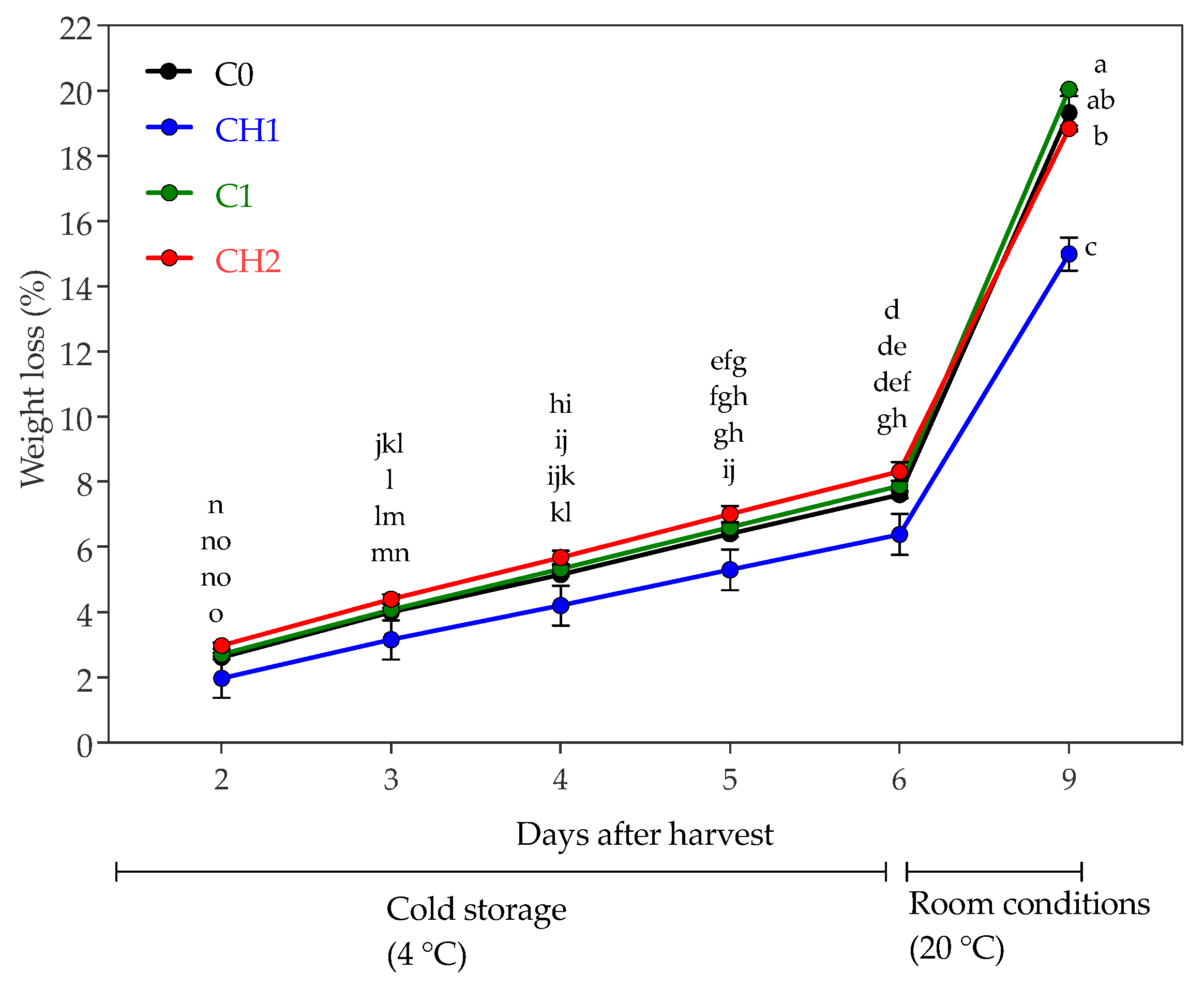
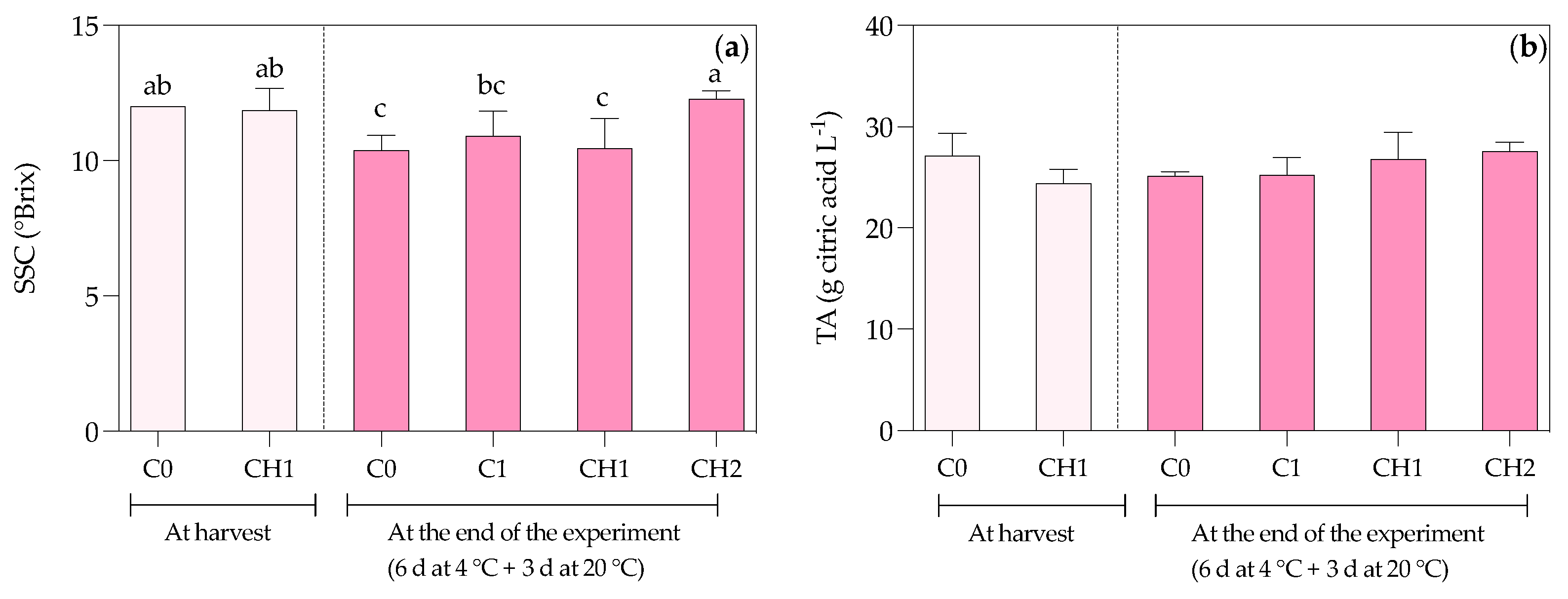
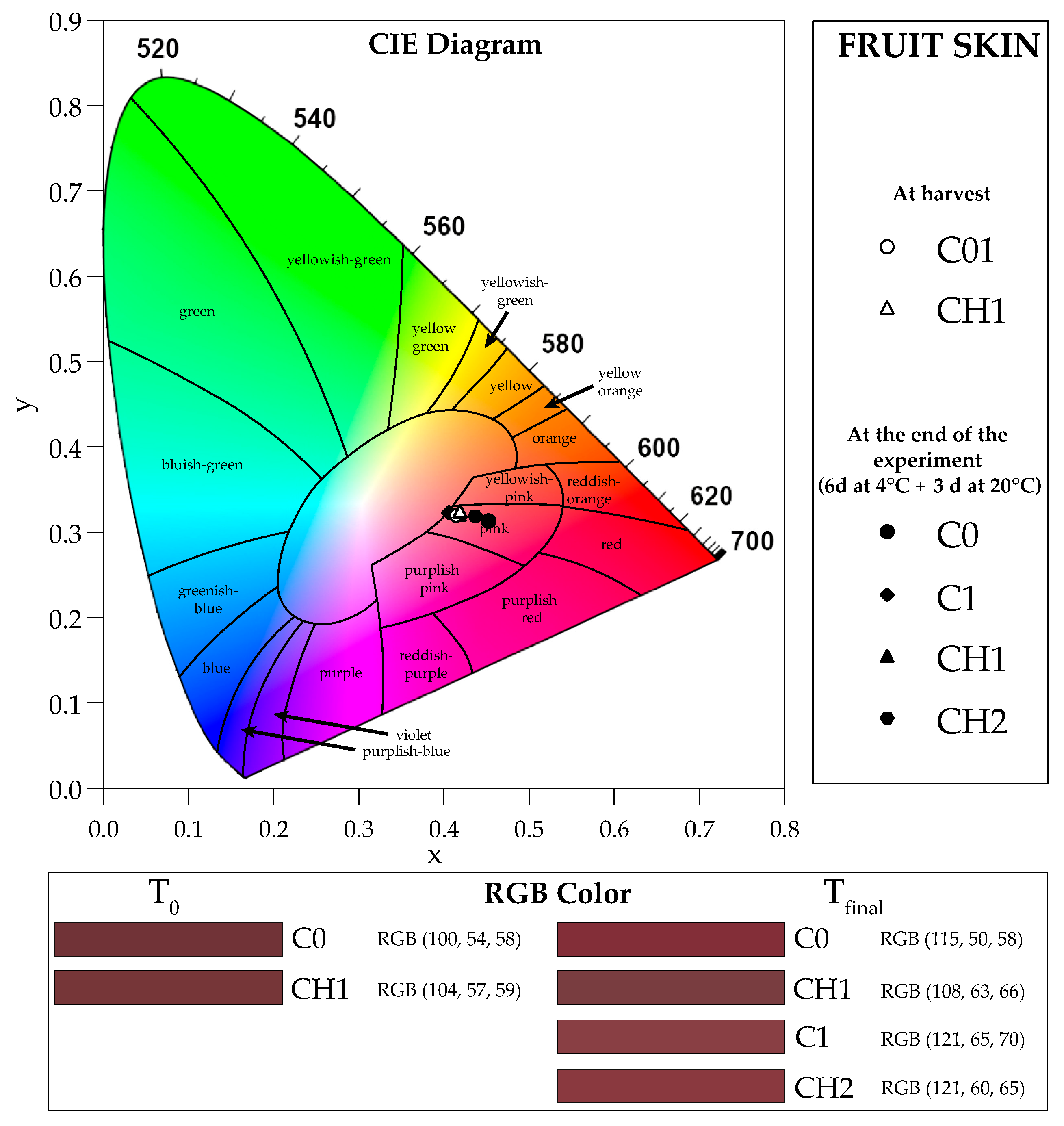
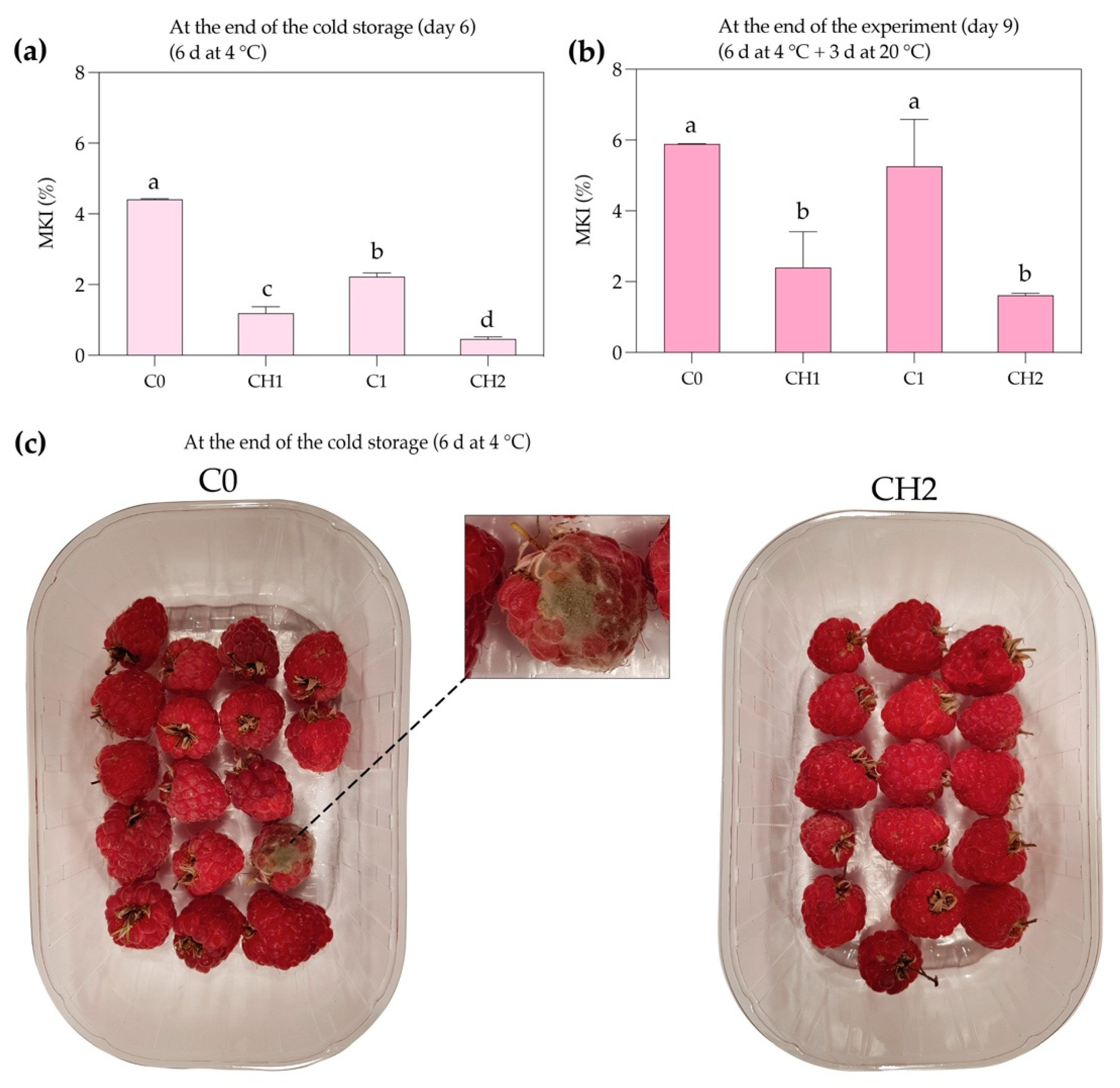
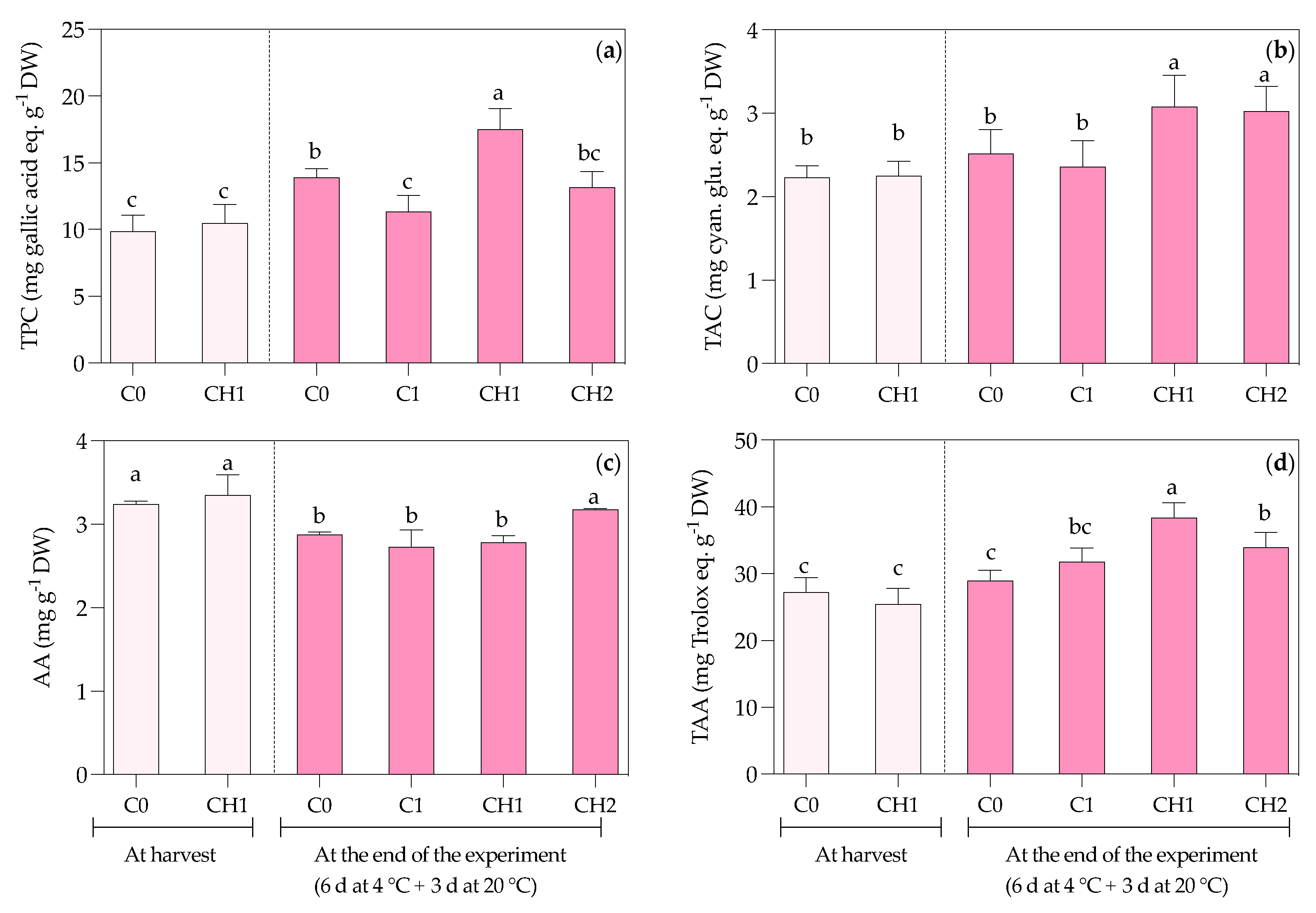
| Treatments | ||
|---|---|---|
| C0 | At harvest | Untreated fruit (control) |
| CH1 | Pre-harvest chitosan (1% v/v) treated fruit | |
| C0 | At the end of the experiment (6 d at 4°C + 3 d at 20°C) |
Untreated fruit (control) |
| C1 | Post-harvest chitosan (1% v/v) treated fruit | |
| CH1 | Pre-harvest chitosan (1% v/v) treated fruit | |
| CH2 | Pre- and post-harvest chitosan (1% v/v) treated fruit |
| CIELAB parameters | ||||||
|---|---|---|---|---|---|---|
| Time | L* | a* | b* | Chroma | Hue | |
| C0 | At harvest | 28.45 ± 2.59b | 21.09 ± 3.74b | 6.32 ± 1.64 | 22.03 ± 4.04c | 17.73 ± 1.57b |
| CH1 | 29.74 ± 1.57b | 21.33 ± 0.84b | 7.65 ± 0.33 | 22.67 ± 0.90c | 21.66 ± 0.25a | |
| C0 | At the end of the experiment (6 d at 4°C + 3 d at 20°C) |
29.95 ± 1.21b | 29.94 ± 2.63a | 8.97 ± 0.98 | 31.29 ± 2.78a | 17.96 ± 1.21b |
| C1 | 32.14 ± 1.36ab | 20.35 ± 0.55b | 6.46 ± 0.44 | 21.37 ± 0.60c | 18.92 ± 1.40b | |
| CH1 | 34.60 ± 1.28a | 24.65 ± 2.51ab | 7.64 ± 1.96 | 26.81 ± 1.02b | 18.69 ± 0.64b | |
| CH2 | 33.28 ± 0.92a | 27.64 ± 7.05ab | 9.07 ± 3.46 | 18.51 ± 1.39bc | 18.89 ± 1.15b | |
Disclaimer/Publisher’s Note: The statements, opinions and data contained in all publications are solely those of the individual author(s) and contributor(s) and not of MDPI and/or the editor(s). MDPI and/or the editor(s) disclaim responsibility for any injury to people or property resulting from any ideas, methods, instructions or products referred to in the content. |
© 2023 by the authors. Licensee MDPI, Basel, Switzerland. This article is an open access article distributed under the terms and conditions of the Creative Commons Attribution (CC BY) license (https://creativecommons.org/licenses/by/4.0/).





